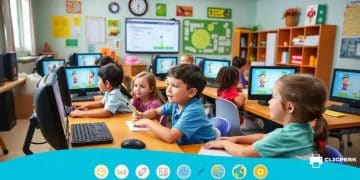Gamification in adult learning: boosting engagement and retention

Anúncios
Gamification in adult learning enhances engagement and retention by incorporating game elements like points, rewards, and challenges, making the educational experience interactive and enjoyable.
Gamification in adult learning is more than just fun and games; it’s a powerful approach to making education more engaging. Have you ever wondered how game elements can transform your learning experience? Let’s dive into this innovative method!
Anúncios
Understanding gamification and its principles
Understanding gamification is essential for educators who want to enhance the learning experience. Gamification combines game elements with educational strategies to motivate learners. By leveraging game-like features, such as competition and rewards, the educational process becomes engaging and fun.
Core Principles of Gamification
There are several core principles behind gamification that educators should consider:
- Incentives: Rewards can encourage participation and effort, driving learners to engage more fully with content.
- Feedback: Immediate feedback helps learners understand their progress, making them feel more empowered.
- Challenges: Setting achievable challenges can boost motivation, as learners enjoy tackling tasks and reaching new levels.
- Community: Fostering a sense of belonging through collaboration can enhance the learning experience.
These principles help in designing a learning environment where students feel invested. When applying gamification, it’s crucial to create a balance between gameplay and educational goals.
Anúncios
The Psychological Impact of Gamification
The psychological impact of gamification plays a significant role in adult learning. Games often create a safe space for risk-taking, encouraging learners to experiment without fear of failure. Adults often return to learning with past experiences that might hinder their progress, but gamification can help mitigate these concerns.
Moreover, the game mechanics can be aligned with adult learning theories. For instance, the use of storytelling in gamification taps into personal narratives, making the learning process relatable and meaningful. This personalized approach increases retention and engagement.
As we explore these concepts, it becomes clear that adapting educational strategies to include gamification can transform traditional learning into an interactive journey. The interplay between education and gaming styles fosters a richer environment, which can lead to improved outcomes.
The role of gamification in adult education
The role of gamification in adult education is significant, as it helps create engaging learning environments. Adults often have different motivations and learning styles compared to younger students. By incorporating game-like elements, educators can tap into these motivations, making the learning process more effective.
Motivating Learners
Gamification serves as a powerful tool for motivating adult learners. Many adults juggle work and family while trying to pursue their education. Therefore, using elements like points, badges, and leaderboards can make learning more appealing and competitive.
- Points can track progress and achievement.
- Badges can symbolize mastery of skills.
- Leaderboards can foster a spirited competition among peers.
This motivation is crucial because it encourages engagement and increases retention rates. When learners see their progress clearly, they are more likely to stay committed.
Enhancing the Learning Experience
By using gamification strategies, educators can enhance the overall learning experience. Activities become more interactive, and students often enjoy the process more. This approach not only makes learning enjoyable but also helps in retaining information.
When adults feel that their learning is relevant and entertaining, they are more determined to participate. For example, using simulations and role-playing can transform dry material into engaging experiences. This active participation allows learners to apply knowledge in practical situations.
A gamified approach can also cater to various learning preferences, ensuring that all students find their learning path engaging. When educators design lessons around gamification principles, they naturally create an inclusive environment.
Strategies for implementing gamification

Strategies for implementing gamification in adult learning can significantly enhance engagement and retention. By integrating game mechanics into educational formats, educators can create a more dynamic and enjoyable learning experience.
Identify Learning Objectives
First, it’s crucial to identify clear learning objectives. Understanding what you want your learners to achieve lays the foundation for effective gamification. Setting specific goals helps learners focus their efforts and recognize their progress.
- Define measurable outcomes.
- Align objectives with real-world applications.
- Consider the learner’s perspective in goal-setting.
By putting these goals at the forefront, you can ensure that gamification will enhance the learning process rather than distract from it.
Integrate Game Elements
To implement gamification effectively, consider incorporating various game elements that resonate with adult learners. Here are some practical techniques to use:
- Points systems: Award points for completing tasks, which can motivate learners to engage.
- Achievements: Provide badges or certificates for major milestones.
- Challenges: Create tasks that encourage problem-solving and collaboration.
These elements can foster a sense of achievement and competition, driving learners to invest more in their education.
Another key strategy is to utilize feedback mechanisms. Regular feedback keeps learners informed about their performance and can guide their next steps. By maintaining communication about progress and areas for improvement, education remains a collaborative effort.
Encourage Collaboration
Encouraging collaboration among learners is a powerful strategy for implementing gamification. Providing opportunities for group activities fosters a sense of community and belonging. Group challenges can also lead to richer discussions and learning experiences.
Adult learners benefit from sharing their perspectives and diverse experiences with one another. Gamification can promote teamwork through various formats, making learning both competitive and cooperative.
Measuring the effectiveness of gamification
Measuring the effectiveness of gamification is vital for ensuring that educational strategies are achieving their intended goals. With the integration of gamification in adult learning, it is important to assess how well these techniques are engaging students and improving retention.
Setting Clear Metrics
To measure effectiveness, educators must establish clear metrics that align with learning objectives. These metrics can include:
- Participation rates: Track how many learners engage with gamified elements.
- Progress tracking: Monitor how quickly and effectively learners are completing tasks.
- Retention rates: Assess how well learners retain information over time.
By collecting data on these parameters, educators can gain insights into the impact of gamification on learning outcomes.
Feedback and Surveys
Another useful strategy involves gathering feedback directly from learners. Surveys and questionnaires can provide insights into their perceptions of gamified learning experiences. Questions can focus on:
- Enjoyment of the gamification elements.
- Perceived effectiveness in understanding course material.
- Motivational factors and impact on learning.
Analyzing this feedback helps educators refine their gamification strategies. If learners feel engaged and motivated, it is a positive sign that the approach is working.
Analyzing Data
Using analytics tools allows educators to analyze the data collected from various metrics effectively. Tracking this data over time can help identify trends and patterns. For example, a decline in participation rates may indicate that elements of the gamification strategy need adjustment.
Ultimately, establishing a robust evaluation process for gamification can lead to continuous improvement. By measuring effectiveness systematically, educators can ensure that gamified environments support effective learning.
Case studies of successful gamification
Case studies of successful gamification provide valuable insights into how this approach can enhance adult learning. By examining real-world examples, educators can see the impact of gamification on engagement and retention.
Case Study 1: Corporate Training
One notable example comes from a large corporate training program that utilized gamification to improve employee onboarding. By integrating a points and rewards system, the company significantly increased participation rates. New employees competed in challenges that required them to learn about company policies and procedures.
- Results: Employees reported a 40% increase in satisfaction with the onboarding process.
- Retention: The retention rate of new hires improved by 30% within the first year.
- Engagement: Participants were more engaged, often sharing their progress on internal social media platforms.
This case highlights the effectiveness of gamification in making training programs more appealing.
Case Study 2: Educational Institution
A university implemented gamification strategies in its adult education programs. By introducing a leaderboard and digital badges for course completions, students felt encouraged to interact more actively with course materials.
- Increased motivation: Enrollment in elective courses rose by 25%.
- Higher completion rates: The rate of course completion increased by 50% compared to previous years.
- Social interaction: Students formed study groups based on their leaderboard rankings, enhancing collaborative learning.
This example shows how gamification can create a more collaborative and motivating environment for adult learners.
Case Study 3: Non-Profit Organization
A non-profit organization aimed at professional development used gamification to enhance participation in workshops. They designed a mobile app where members could earn points for attending events and completing activities.
- Engagement: Participation in workshops increased by 60%.
- Feedback: Participants reported finding the workshops more enjoyable and relevant.
- Community building: The app fostered a sense of community among participants as they shared their achievements.
This case illustrates the capacity for gamification to enhance engagement within professional development contexts.
FAQ – Frequently Asked Questions about Gamification in Adult Learning
How does gamification enhance engagement in adult education?
Gamification incorporates game elements like points and challenges, making learning more interactive and enjoyable, which boosts participant engagement.
What are some effective gamification strategies for adult learners?
Effective strategies include using points systems, creating achievements, providing immediate feedback, and encouraging collaborative activities.
Can you provide examples of successful gamification case studies?
Yes, successful cases include corporate training programs that improved onboarding participation and universities that increased course completion rates through gamification.
How do we measure the effectiveness of gamification?
Effectiveness can be measured through participation rates, retention rates, feedback from learners, and analyzing performance data over time.





